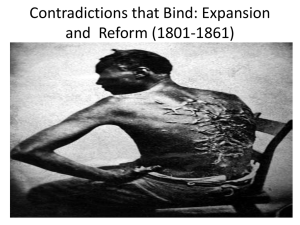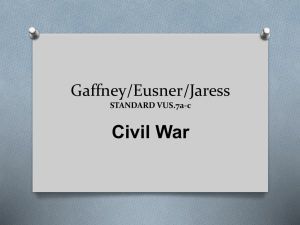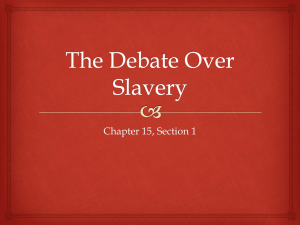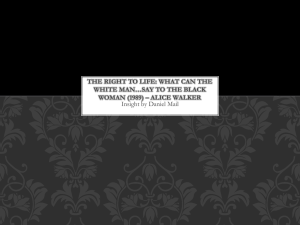America`s History Fifth Edition
advertisement
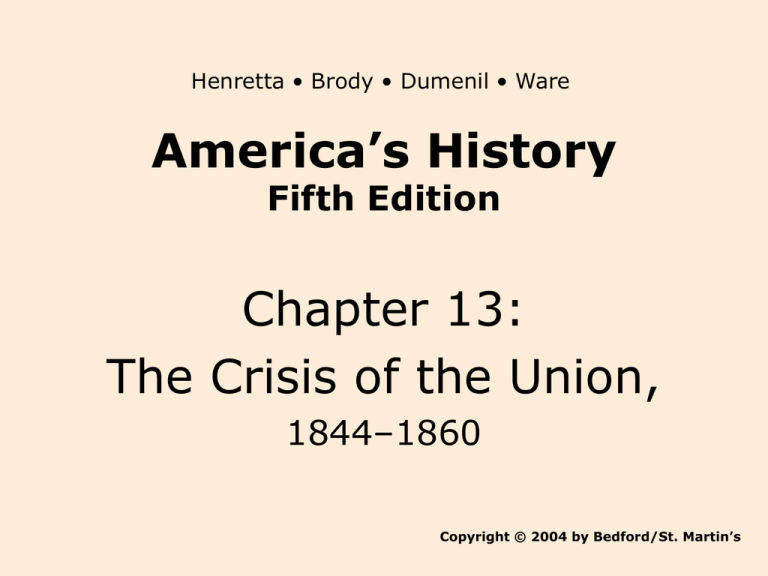
Henretta • Brody • Dumenil • Ware America’s History Fifth Edition Chapter 13: The Crisis of the Union, 1844–1860 Copyright © 2004 by Bedford/St. Martin’s War News from Mexico, by Richard Caton Woodville, 1848 (p. 366) Figure 13.1 The Surge in Cotton Production, 1835–1860 (p. 368) I. Manifest Destiny A. The Mature Cotton Economy, 1820 – 1860 1. 2. 3. By 1820 the South produced more raw cotton than any other country in the world; to increase output, some slave owners created the gang-labor system. By 1860, nearly two million slaves were laboring in the lower Mississippi Valley and along the “black belt” from Mississippi through Georgia. Planters justified their power by arguing that slavery was a “positive good” that allowed a civilized lifestyle for whites and provided tutelage for genetically inferior Africans. I. Manifest Destiny A. The Mature Cotton Economy, 1820 – 1860 4. 5. 6. 7. White politics and society in the South were deeply divided along the lines of class and religion. In theory, masters had unlimited power over their slaves; in practice, however, both social conventions and black resistance limited a master’s power. The institutions of slavery became a part of the fiber of American life, and white southerners wanted to extend its sway across the entire continent. These incidences illustrate the severe cultural divide between the north and south. I. B. Manifest Destiny The Independence of Texas 1) 2) 3) 4) 5) The Adams-Onis Treaty of 1819 guaranteed Spanish sovereignty over Texas. After winning independence from Spain in 1821, the Mexican government, short on population and cash for settling the region, encouraged settlement by both Mexicans and migrants from the United States. In 1829 the Americans won special exemption from a law ending slavery in Mexico. By the 1830s, Americans in Texas has split into two groups: the “peace party” wanted more self-government for the province, and the “war party” wanted independence from Mexico. The push for expansionism, driven by economic “needs” created a tension between the two nations. Map 13.1 American Settlements in Texas, 1821–1836 (p. 371) I. B. Manifest Destiny The Independence of Texas 5) 6) 7) 8) On March 2, 1836, the war party proclaimed the independence of Texas and adopted a constitution legalizing slavery. General Antonia Lopez de Santa Anna’s army wiped out the war party’s garrison that was defending the Alamo and then captured Goliad. With reinforcements and the leadership of General Sam Houston, the war party routed the Mexicans in the Battle of San Jacinto, establishing de facto independence. President’s Jackson and Van Buren refused to allow the annexation of Texas; they felt its status as a slave state would divide the Democratic Party and lead to war with Mexico. Assault on the Alamo (p. 371) Sam Houston, by Martin Johnson Heade, 1846 (p. 373) I. C. Manifest Destiny The Push to the Pacific: Oregon and California 1) 2) 3) In 1845, John L. O’Sullivan coined the phrase Manifest Destiny; he felt that Americans had a right to develop the entire continent as they saw fit, which implied a sense of cultural and racial superiority. The Oregon country stretched along the Pacific coast from the forty-second parallel in the south to 54˚40’ in the north and was claimed by both Great Britain and the United States. “Oregon fever” raged in 1843 as thousands journeyed for months across the continent to the Willamette Valley to pursue farming and the china and fur trades. Map 13.2 Territorial Conflict in Oregon, 1819–1846 (p. 373) I. Manifest Destiny C. The Push to the Pacific: Oregon and California 4) 5) 6) By 1860, about 350,000 Americans journeyed the Oregon Trail; many died en route from disease and exposure, although relatively few died from Indian attacks. Some left the Oregon Trail and traveled south along the California Trail, settling along the Sacramento River. To promote California’s development, the Mexican government took over the California missions and promoted large-scale cattle ranching. Map 13.3 Routes to the West, 1835–1860 (p. 374) I. Manifest Destiny C. The Push to the Pacific: Oregon and California 7) 8) The rise of cattle ranching created a new society and economy as agents from New England firms assimilated Mexican life and married into the families of the Californios. Some California settlers hoped to emulate the Americans who colonized Texas and sought annexation into the United States; however, at that time American settlers in California were too few. I. Manifest Destiny D. The Fateful Election of 1844 1) 2) 3) Southern leaders favored territorial expansion to extend the slave system and demanded the immediate annexation of Texas. In an effort to end joint occupation of Oregon, in 1843 a bipartisan national convention demanded that the United States seize Oregon all the way to 54˚40’ north latitude. Texas became the central issue in the 1844 election; Democrats selected James K. Polk, who called for the annexation of Texas and the taking of all of Oregon. I. Manifest Destiny D. The Fateful Election of 1844 4) 5) The Whigs nominated Henry Clay, who suggested that he might support annexation of Texas. Polk’s method of linking the issues of Texas and Oregon was successful; immediately after Polk’s victory, congressional Democrats moved to bring Texas into the Union. II. War, Expansion, and Slavery, 18461850 A. The War with Mexico, 1846-1848 1) 2) 3) Mexico was determined to retain its territories, and when the Texas Republic accepted American statehood in 1845, Mexico broke off diplomatic relations with the United States. President Polk ordered General Zachary Taylor to occupy the disputed lands between the Nueces River and the Rio Grande. Polk sent John Slidell to Mexico City to secure Mexican acceptance of the Rio Grande boundary and to buy Mexico and California. II. War, Expansion, and Slavery, 18461850 A. The War with Mexico, 1846-1848 4) 5) 6) Mexican officials refused to see Slidell and declared that the annexation of Texas was illegal. In October 1845, at Polk’s request, Thomas O. Larkin encouraged the leading Mexican residents of Monterey, California, to declare independence and support peaceful annexation. Naval commanders in the Pacific were told to seize California’s coastal towns in case of war, and Captain John C. Fremont’s heavily armed troops were sent deep into Mexican territory. Street Fighting in the Calle de Iturbide, 1846 (p. 377) II. War, Expansion, and Slavery, 18461850 A. The War with Mexico, 1846-1848 7) 8) 9) Hoping to incite an armed Mexican response, Polk ordered General Taylor to build a fort near the Rio Grande; when a clash occurred, Polk blamed the Mexicans for the bloodshed. Whigs wanted a peaceful resolution, but the Democratic majority in Congress voted for war with Mexico. To avoid simultaneous war with Britain, the president signed the Oregon Treaty, which divided the Oregon region at the forty-ninth parallel. II. War, Expansion, and Slavery, 18461850 A. The War with Mexico, 1846-1848 10) By the end of 1846, the United States controlled much of northeastern Mexico, and American forces secured control of California in 1847. 11) Santa Anna went on the offensive attacking Zachary Taylor’s unit at Buena Vista in 1847, and only superior artillery enabled a narrow American victory. 12) General Winfield Scott’s troops seized Mexico City in September 1847; Santa Anna was overthrown, and the new Mexican government agreed to make peace. Map 13.4 The Mexican War, 1846–1848 (p. 378) II. War, Expansion, and Slavery, 18461850 B. A Divisive Victory 1) 2) 3) “Conscience Whigs” viewed the Mexican War as a conspiracy to add new slave states in the West, and Polk’s expansionist policy split the Democrats into sectional factions. The Wilmot Proviso (1846) was intended to prohibit slavery in any new territories acquired from Mexico; the Senate killed the proviso. Although the Wilmot Proviso didn’t pass, it illustrated the rising tensions and foreshadows larger conflicts to come. To reunite Democrats before the election, Polk and Buchanan abandoned their expansionist hopes for Mexico and agreed to take only California and New Mexico. Map 13.5 The Mexican Cession, 1848–1853 (p. 382) II. War, Expansion, and Slavery, 18461850 B. A Divisive Victory 4) 5) 6) In the treaty of Guadalupe Hidalgo (1848) the United States agreed to pay Mexico $15 million for Texas north of the Rio Grande, New Mexico, and California. Many northerners joined a new “free-soil” movement, viewing slavery as a threat to Republicanism and the yeoman farmers. The Wilmot Proviso’s call for free soil was the first antislavery proposal to attract broad popular support. II. War, Expansion, and Slavery, 18461850 B. A Divisive Victory 7) 8) 9) Democrats nominated Lewis Cass as their presidential candidate; Cass was an avid expansionist who proposed “squatter sovereignty” and was deliberately vague on the issue of slavery in the West. The Free-Soilers chose Martin Van Buren for President; the Whigs nominated General Zachary Taylor, a slave owner who had not taken a position on slavery in the territories. Taylor and his running mate Millard Fillmore won the election, but the electoral margin was thin due to the free-soil ticket taking New York’s vote. II. War, Expansion, and Slavery, 18461850 C. 1850: Crisis and Compromise 1) 2) 3) In 1848, flakes of gold were found in the Sierra Nevada foothills, and by 1849, “forty-niners” were pouring into California in search of gold. The influx of settlers revived the national debate over free soil; in November 1849, Californians ratified a state constitution that prohibited slavery. The admission of California as a state threatened the carefully maintained balance of slave states versus nonslave states in the Senate. II. War, Expansion, and Slavery, 18461850 C. 1850: Crisis and Compromise 4) 5) 6) Southern leaders decided to block California’s entry unless the federal government guaranteed the future of slavery. John C. Calhoun warned of possible secession by slave states and civil war; he advanced the doctrine that Congress had no constitutional authority to regulate slavery in the territories.( difference in political opinion between the north and south as well) Many southerners and some northern Democrats were willing to extend the Missouri Compromise line to the pacific Ocean, guaranteeing slave owners some western territory. II. War, Expansion, and Slavery, 18461850 C. 1850: Crisis and Compromise 7) 8) 9) A third choice, squatter (popular) sovereignty, placed decisions about slavery in the hands of local settlers and their territorial governments. Whigs and Democrats desperately sought a compromise to preserve the Union; Whigs organized the Compromise of 1850. The compromise included a Fugitive Slave Act to mollify the South, and, to mollify the North, it admitted California as a free state and abolished the slave trade in Washington, D.C. Map 13.7 The Compromise of 1850 and the Kansas-Nebraska Act of 1854 (p. 386) Writing Prompts; sections 1 and 2 1. What were the most important causes of the war with Mexico? 2. Was the Treaty of Guadalupe Hidalgo fair or unfair to Mexico? 3. How do you think the Californios viewed the influx of Americans in the 1840s and 1850s? III. The End of the Second Party System, 1850-1858 A. Resistance to the Fugitive Slave Act 1) 2) The plight of runaway slaves and the appearance of slave catchers aroused popular hostility in the North and Midwest, and free blacks and abolitionists defied the new law. Harriet Beecher Stowe’s Uncle Tom’s Cabin (1852), which evoked sympathy for slaves and outrage against slavery throughout the North, increased northern opposition to the act. Uncle Tom’s Cabin, 1852 (p. 387) III. The End of the Second Party System, 1850-1858 A. Resistance to the Fugitive Slave Act 3) 4) Northern legislatures enacted personal liberty laws, and in Ableman v Booth (1857) the Wisconsin Supreme Court said the act violated the Constitution. The U.S. Supreme Court in 1859 upheld the constitutionality of the Fugitive Slave Act, but by then the act had become a “dead letter.” III. The End of the Second Party System, 1850-1858 B. The Whigs’ Decline and the Democrats’ Diplomacy 1) 2) 3) Conflict over fugitive slaves split the Whig Party; one-third of the Whigs gave their support to the Democrats in the 1852 election. Democrats were divided at their convention and no candidate could secure the necessary two-thirds majority, so they settled on a compromise nominee, Franklin Pierce. The Democrats swept the election, and their party was reunited; conversely, the Whig Party split into sectional wings. III. The End of the Second Party System, 1850-1858 B. The Whigs’ Decline and the Democrats’ Diplomacy 4) 5) Pierce pursued an expansionist foreign policy to assist northern merchants, secured railroad rights in northern Mexico with the Gadsden Purchase, and tried to seize Cuba, issuing the Ostend Manifesto (1854). Northern opposition to the Manifesto forced Pierce to halt efforts to take Cuba, but it revived the northern fears of a “Slave Power” conspiracy. III. The End of the Second Party System, 1850-1858 C. The Kansas-Nebraska Act and the Rise of New Parties 1) 2) 3) The Kansas-Nebraska Act, constructed by Democrat Stephen Douglas, divided the northern Louisiana Purchase into two territories, Kansas and Nebraska, and voided the Missouri Compromise line by opening the area to slavery through the principle of popular sovereignty. The Kansas-Nebraska Act passed in 1854 and proved to be the end of the Second Party System. Antislavery northern Whigs and Anti-Nebraska Democrats formed a new party, the Republicans. Map 13.6 The California Gold Rush, 1849–1857 (p. 385) III. The End of the Second Party System, 1850-1858 C. The Kansas-Nebraska Act and the Rise of New Parties 4) 5) 6) The American, or “Know-Nothing” Party, had its origins in the anti-immigrant and anti-Catholic organizations of the 1840s. In 1855 the Pierce administration recognized the territorial legislature in Lecompton, Kansas, which had adopted proslavery legislation. Free-Soilers rejected the legitimacy of the territorial government; proslavery and antislavery sides turned to violence. III. The End of the Second Party System, 1850-1858 D. The Election of 1856 and Dred Scott 1) 2) 3) 4) The Republican Party nominated Colonel James C. Fremont, a Free-Soiler. The American Party split into sectional factions, the northern faction endorsed Fremont, and the southern faction nominated Millard Fillmore. The Democrats nominated James Buchanan as their presidential candidate in the election of 1856. James Buchanan won; the Republicans had replaced Whigs as the second major party. III. D. The End of the Second Party System, 1850-1858 The Election of 1856 and Dred Scott 5) 6) 7) 8) In Dred Scott v. Sandford (1856), the US Supreme Court opined that a slave’s residence in a free state did not make him a free man and that African Americans were not citizens and could not sue in a federal court. Chief Justice Taney declared the Missouri Compromise unconstitutional and endorsed Calhoun’s interpretation of popular sovereignty: only when settlers wrote a constitution and requested statehood could they prohibit slavery. In 1858, Buchanan recommended the admission of Kansas as a slave state; this, in addition to the Dred Scott decision, split his party and the nation. This occurrence shattered any past or future attempts (such as the Missouri Compromise) to make a peaceful compromise between the north and south. Map 13.8 Political Realignment, 1848–1860 (p. 392) Map 13.8 Political Realignment, 1848–1860 (p. 392) Map 13.8 Political Realignment, 1848–1860 (p. 392) Map 13.8 Political Realignment, 1848–1860 (p. 392) Writing Prompts; sections 2 and 3 1. 2. How do you explain northern attempts to circumvent the Fugitive Slave Act with personal liberty laws and denunciations of states’ rights theory? Why didn’t popular sovereignty resolve the issue of slavery in the territories? IV. Abraham Lincoln and the Republican Triumph, 1858-1860 A. Lincoln’s Political Career 1) 2) 3) Abraham Lincoln came from an illiterate yeoman farming family in Illinois; in 1831, he rejected the farmers’ life and became a store clerk. Lincoln was an ambitious man: he was admitted to the bar in 1837, and he served four terms as a Whig in the Illinois assembly. In 1846, Lincoln won election to Congress, where he had to take a stand on the issue of slavery; he felt that slavery was unjust but did not believe that the federal government had the constitutional authority to tamper with it. IV. Abraham Lincoln and the Republican Triumph, 1858-1860 A. Lincoln’s Political Career 4) 5) 6) Lincoln argued that prohibiting the expansion of slavery, gradual emancipation, and the colonization of freed slaves were the only practical ways to address the issue. Both abolitionists and proslavery activists derided Lincoln’s pragmatic policies, and for a while he withdrew from politics in order to devote his time to law. Lincoln later attacked the doctrine of popular sovereignty and said he would leave slavery where it existed but not extend it into the territories. IV. Abraham Lincoln and the Republican Triumph, 1858-1860 A. Lincoln’s Political Career 7) 8) 9) Lincoln abandoned the Whig Party and joined the Republicans; he soon emerged as their leader in Illinois. In Lincoln’s “House Divided” speech, he predicted a constitutional crisis over slavery. In the 1858 duel for the US Senate, Stephen Douglas declared his support for white supremacy, and Lincoln advocated economic opportunities for blacks. IV. Abraham Lincoln and the Republican Triumph, 1858-1860 A. Lincoln’s Political Career 10) Douglas’s “Freeport Doctrine” asserted that settlers could exclude slavery by not adopting local legislation to protect it; this upset proslavery advocates and abolitionists. 11) Douglas was elected to the Senate, but Lincoln had established himself as a national leader. IV. Abraham Lincoln and the Republican Triumph, 1858-1860 B. The Party System Fragments 1) 2) 3) Southern Democrats divided into two groups: the “Moderates” (Southern Rights Democrats) pursued protection of slavery in the territories, and the “Radicals” promoted secession. In October 1859, John Brown led a raid that temporarily seized the federal arsenal at Harpers Ferry, Virginia; his purpose was to supply the arms for a slave rebellion. Brown was charged with treason, sentenced to death, and hanged. He was a martyr to abolitionists. IV. Abraham Lincoln and the Republican Triumph, 1858-1860 B. The Party System Fragments 4) 5) 6) In 1860, northern Democrats rejected Jefferson Davis’s program to protect slavery in the territories; Republicans opposed both slavery and radical equality. The election of 1860 had four candidates: Stephen Douglas, John C. Breckinridge, John Bell, and Abraham Lincoln. Lincoln garnered a majority in the electoral college; the Republicans had united the Northeast, the Midwest, and the Far West behind free soil and had seized national power. Writing Prompts; sections 3 and 4 1. 2. 3. 4. Was John Brown justified in his action at Harpers Ferry? Why or why not? Why was Lincoln chosen to be the Republican Party candidate for president in 1860? How could Lincoln have reassured southerners before his election? Which of the following was the most important cause of the Civil War: economic differences, political failures, or slavery?

